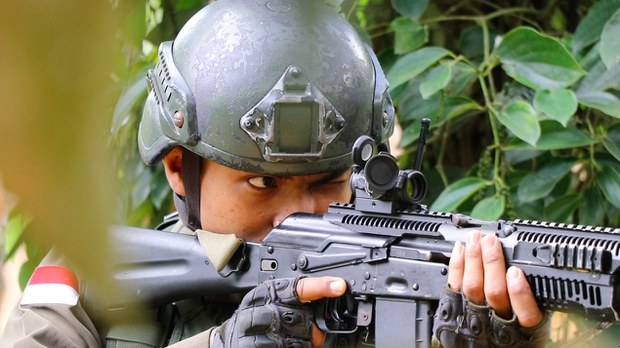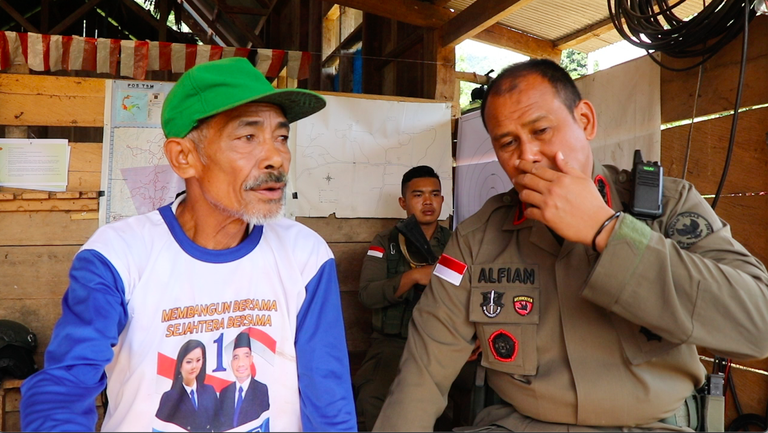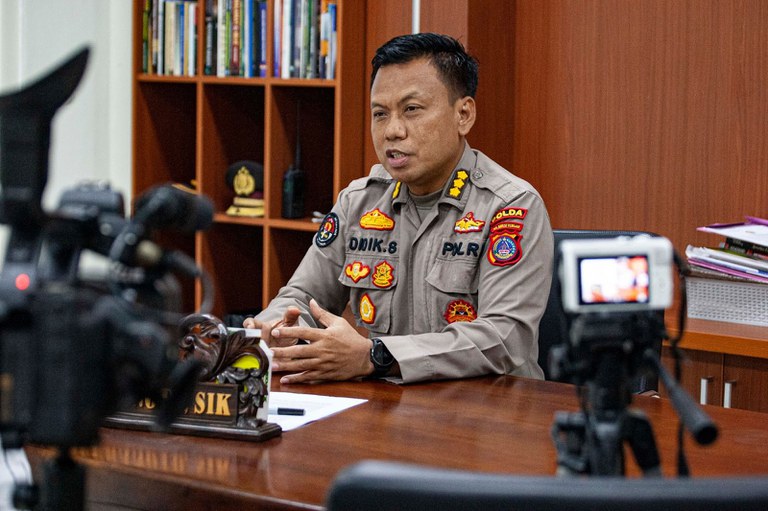Indonesia’s manhunt for MIT holdouts drags on
2022.04.05
Poso, Indonesia
 A member of Indonesia’s Madago Raya Task Force takes aim during a patrol to hunt down three remaining members of the Eastern Indonesia Mujahideen group, in Poso Pesisir, a district in Poso regency, Central Sulawesi, Feb. 26, 2022.
A member of Indonesia’s Madago Raya Task Force takes aim during a patrol to hunt down three remaining members of the Eastern Indonesia Mujahideen group, in Poso Pesisir, a district in Poso regency, Central Sulawesi, Feb. 26, 2022.
The men moved stealthily through the jungle, squatting back-to-back, aiming their weapons into the green shadows and spaces as they scanned the terrain in search of an elusive target.
They carried loaded Steyr rifles, AK-101s, and Sig Sauer pistols as they patrolled a mountainside in Indonesia’s Central Sulawesi province, as part of a manhunt to catch or kill members of the dreaded pro-Islamic State MIT group – all three of them.
A BenarNews reporter tagged along with security personnel as they combed the steep and rugged terrain in late February. The three suspects have evaded capture since security forces killed Ali Kalora, the group’s most recent leader, in a shootout last September.
“Our task here is to continue the hunt for fugitive terrorists who are still hiding in the forest. … We hope they turn themselves in peacefully. We will facilitate that. If not, we will continue to limit them so they won’t be able to spread radical ideas to the public,” Arif Budiman, the commander of the Madago Raya Task Force and a police grand commissioner, told BenarNews.
Over the years, a series of security operations consisting of more than a thousand soldiers and police have failed to entirely eliminate the Eastern Indonesia Mujahideen (MIT). Even after its numbers dwindled to fewer than 10, the group still managed to strike fear among locals by beheading farmers and villagers in recent attacks.
Back on the mountainside, operations commander Mokhamad Alfian Hidayat told BenarNews that similar patrols were carried out every day. Apart from hunting for the militants, they were intended to help the area’s residents feel safe, he said.
“[Sometimes] we deploy troops from helicopters if we suspect the terrorists are hiding out in areas that are difficult to reach on foot, because the forest is steep and you have to wade across rivers,” added Alfian, a police grand commissioner with the local Mobile Brigade (Brimob).
MIT formed in 2010 as a by-product of Christian-Muslim sectarian violence in Poso town that left more than 1,000 people dead between 1998 and 2001. The group is notorious for executing suspected informants and being the first Indonesian militant outfit to pledge allegiance to the Islamic State (IS) terror group.
Security operations to defeat MIT have gone through several iterations with different names. Madago Raya, formed in 2021, is smaller than previous task forces, but still comprises more than 1,300 personnel, including 267 soldiers and 1,111 police officers, according to officials.
Critics say this number is excessive for hunting down only three militants who are considered to be low-level operatives.
The three fugitives, according to the task force, are Suhardin, 37, who is also known as Hasan Pranata, Farhan, or Abu Farhan; Hamzah, 30, who is also known as Imam, Galuh, or Nae; and Alikhwarisman, 34, who is also known by the aliases Askar, Jafar, Jaid, and Pak Guru.
With the current leadership vacancy, it should be easier to find them, said Andi Akbar, a member of the Central Sulawesi Muslim Defender Team (TPM), a group committed to providing legal aid to people accused of being terrorists.
In his view, the size of the task force is overblown and “exaggerated” because the fugitives are leaderless individuals with no tactical capabilities compared with their slain leader.
“Deploying more than a thousand troops with such a large budget and then [for] such a long period of time, but until this moment the MIT case has yet to see the end,” he told BenarNews.

Didik Supranoto, another police grand commissioner who heads Madago Raya’s public relations unit, acknowledged that the force was large, but said its personnel included those working to protect the area’s residents and to prevent radicalization among the local populace.
These operations, he said, include activities such as arranging for and sending moderate religious preachers to talk to residents, and helping them set up find work or set up small businesses.
“They are also deployed to protect local people from the latent dangers of terror, not just for hunting [the militants]. Besides, the operation area is really wide and it requires a sufficient number of troops,” Didik told BenarNews.
Madago Raya is divided into three operating areas that cover Poso, Sigi, and Parigi Moutong regencies, areas of Central Sulawesi where MIT long held sway.
Another allegation leveled against the task force by Andi Akbar of TPM and some activists is that Madago Raya is intentionally letting the remaining three militants roam freely, so that local authorities can keep funds for the task force rolling in from the central government in Jakarta.
“There is a possibility that the Madago Raya Task Force is deliberately buying time or leaving them there to keep operating funds flowing,” Andi said.
Arif, the task force commander, rejected Akbar’s accusation as “absolutely not true.”
“The search is not as easy as people think, because of many factors, including the steep and wide terrain and the shrewdness of the fugitives in hiding from officers,” he told BenarNews.
However, Nasir Abas, a former top member of another militant group, Jemaah Islamiyah, said one reason the three militants could be eluding capture is that locals were shielding them. JI, the Southeast Asian affiliate of the al-Qaeda global militant network, was blamed for Indonesia’s deadliest ever terror attack, the Bali bombings that killed 202 people in 2002.
“The people there are secretly protecting them. So, it will not be easy to catch them,” Nasir told BenarNews in Jakarta.
Because the task force is aware of this possibility, it is prioritizing using persuasion through ex-militant convicts to figure out the whereabouts of the fugitives, said Adjutant Police Commissioner Yudho Huntoro, deputy spokesman for Madago Raya.
In fact, Nasir Abas and Bali bombing convict Ali Imron worked similarly with police to uncover the whereabouts of secret Jemaah Islamiyah networks.

During a casual conversation at a coffee shop in Poso, several locals told BenarNews that the fugitives were reluctant to surrender because they did not believe the task force would keep its promise of not shooting or torturing them.
One local said: “Police usually shoot terrorists straight away to take revenge for killing their friends,” a local said.
Yudho denied the locals’ assertion.
“It would be great if the fugitives want to surrender to us, to the police and the army. We will guarantee their safety,” he said.
Meanwhile, a number of residents in Poso also said they felt safer now compared with before, but that a latent threat lingered.
Yunus Laode, a local farmer, for one, said the task force needed to be maintained.
“I’ve seen people beheaded, it was horrible. I think that’s enough,” Yunus, 88, told BenarNews.
“That’s why I ask the police and the army to stay here so that we are safe.”

In May 2021, when MIT militants killed four farmers in Kalemago, a village in Poso regency, one of the victims was found decapitated, Didik said at the time. In a separate attack in November 2020, another victim was also beheaded.
Alfian, the Madago Raya Task Force commander, agreed with the locals who said militancy was still a threat. He said there was a danger that the younger generation in families of militants who were convicted or killed might join or form groups like MIT.
Therefore, he said, it is essential the operation to flush out the remaining three MIT militants is completed immediately.
To speed up operations, the Madago Raya Task Force has dispatched 200 intelligence personnel to find out the whereabouts of the fugitive militants, Alfian said.
“The problem is that [the fugitives] know the … terrain very well. So, it’s easy for them to hide,” Alfian said.
“It’s like three fish in a thousand hectares of pond.”
Keisyah Aprilia in Palu, Indonesia contributed to this report.







